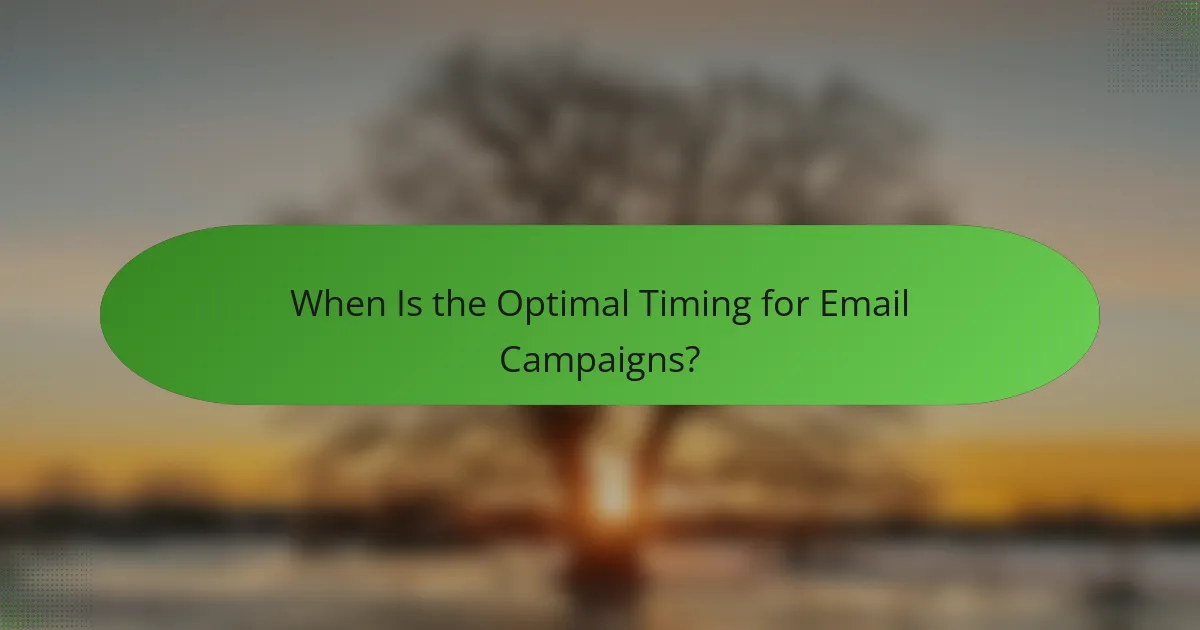Email campaigns are a powerful tool for reaching your audience, but their success hinges on effective content, design, and timing. Crafting personalized messages with compelling subject lines and clear calls-to-action is essential for engagement. Additionally, employing visually appealing designs and understanding the best times to send your emails can significantly boost your campaign’s performance.

How to Create Effective Email Campaign Content?
Creating effective email campaign content involves crafting messages that resonate with your audience while encouraging engagement. Focus on personalization, compelling subject lines, and clear calls-to-action to maximize your campaign’s impact.
Personalization Techniques
Personalization techniques enhance the relevance of your emails by tailoring content to individual recipients. Use data such as names, past purchases, or browsing behavior to create a more engaging experience. For example, addressing a subscriber by their first name can increase open rates significantly.
Segment your audience based on demographics or interests to send targeted messages. This can involve grouping subscribers by location, age, or previous interactions with your brand. Personalized content can lead to higher conversion rates and customer loyalty.
Compelling Subject Lines
Compelling subject lines are crucial for capturing attention and encouraging opens. Aim for clarity and intrigue, keeping them concise—ideally under 50 characters. A/B testing different subject lines can help identify what resonates best with your audience.
Incorporate urgency or exclusivity, such as “Limited Time Offer” or “Exclusive Access for Subscribers,” to prompt immediate action. Avoid using all caps or excessive punctuation, as these can trigger spam filters and reduce deliverability.
Call-to-Action Strategies
Effective call-to-action (CTA) strategies guide recipients on what to do next. Use clear, action-oriented language like “Shop Now,” “Download Free Guide,” or “Join Our Webinar.” Place CTAs prominently within the email to ensure they are easily visible.
Consider using buttons instead of text links for CTAs, as they stand out more and can improve click-through rates. Test different placements and designs to see what drives the best results. Ensure that your CTAs are relevant to the content and offer clear value to the reader.

What Are the Best Design Practices for Email Campaigns?
The best design practices for email campaigns focus on creating visually appealing, user-friendly layouts that enhance engagement. Key elements include responsive design, brand consistency, and effective visual hierarchy to ensure your message is clear and accessible across devices.
Responsive Design Principles
Responsive design ensures that your email displays correctly on various devices, from desktops to smartphones. Use fluid grids and flexible images that adjust to different screen sizes, allowing for a seamless user experience.
Test your emails on multiple devices and email clients to identify any formatting issues. Aim for a single-column layout for mobile devices, as it simplifies navigation and improves readability.
Brand Consistency in Email Layout
Maintaining brand consistency in your email layout reinforces recognition and trust. Use your brand colors, fonts, and logos consistently throughout your emails to create a cohesive look.
Incorporate familiar design elements, such as button styles and header formats, that align with your overall branding strategy. This consistency helps recipients quickly identify your emails in their inbox.
Visual Hierarchy and Readability
Establishing a clear visual hierarchy guides readers through your email content. Use headings, subheadings, and bullet points to break up text and highlight key information, making it easier for recipients to scan your message.
Ensure that your font sizes are legible, with a minimum of 14px for body text and larger sizes for headings. Use ample white space to enhance readability and draw attention to important elements.

When Is the Optimal Timing for Email Campaigns?
The optimal timing for email campaigns largely depends on your target audience and their habits. Generally, sending emails during peak engagement times can significantly enhance open and click-through rates.
Best Days and Times to Send Emails
Research indicates that Tuesdays, Wednesdays, and Thursdays are often the best days to send emails, as people are more likely to engage during the middle of the week. The ideal times tend to be late mornings and early afternoons, typically between 10 AM and 2 PM.
However, testing your specific audience is crucial. Consider segmenting your list and experimenting with different days and times to find what works best for your subscribers.
Frequency of Email Campaigns
Finding the right frequency for email campaigns is essential to maintain engagement without overwhelming your audience. A common approach is to send emails once a week or bi-weekly, allowing enough time for recipients to digest content without feeling bombarded.
Monitor your open and unsubscribe rates to adjust your frequency. If you notice a decline in engagement, it may be a sign to reduce the number of emails sent.
Seasonal Timing Considerations
Seasonal events can greatly influence the timing of your email campaigns. For instance, during the holiday season, consumers are more receptive to promotional emails, making it an ideal time to increase your outreach.
Additionally, consider industry-specific events or trends. For example, retailers might focus on back-to-school promotions in late summer, while travel companies may ramp up campaigns in early spring for summer vacations.

What Metrics Should You Track for Email Campaign Success?
To measure the success of your email campaigns, focus on key metrics such as open rates, click-through rates, conversion rates, and unsubscribe rates. These indicators provide insights into how well your emails are performing and where improvements can be made.
Open Rates and Click-Through Rates
Open rates indicate the percentage of recipients who opened your email, while click-through rates (CTR) measure the percentage of those who clicked on links within the email. A good open rate typically ranges from 15% to 25%, depending on the industry, while CTRs can vary from 1% to 5%.
To improve these metrics, consider crafting compelling subject lines and ensuring your emails are mobile-friendly. A/B testing different subject lines and content can help identify what resonates best with your audience.
Conversion Rates and ROI
Conversion rates reflect the percentage of recipients who completed a desired action, such as making a purchase or signing up for a service, after clicking through your email. Return on investment (ROI) measures the profitability of your campaign, calculated by comparing the revenue generated against the costs incurred.
A healthy conversion rate often falls between 1% and 5%. To enhance conversions, ensure your email content aligns with the landing page and includes clear calls to action. Monitoring ROI helps you allocate resources effectively for future campaigns.
Unsubscribe Rates
Unsubscribe rates indicate the percentage of recipients who opted out of your mailing list after receiving an email. A typical unsubscribe rate is around 0.2% to 0.5%, but higher rates may signal issues with content relevance or frequency.
To minimize unsubscribes, regularly evaluate your email content and frequency. Providing options for recipients to adjust their preferences can also help retain subscribers who may not want to receive certain types of emails.

How to Segment Your Email List Effectively?
Effective email list segmentation involves dividing your audience into distinct groups based on specific criteria, allowing for tailored messaging that resonates with each segment. This targeted approach increases engagement and conversion rates by delivering relevant content to the right recipients.
Demographic Segmentation
Demographic segmentation categorizes your email list based on characteristics such as age, gender, income, education, and location. This method helps you understand the unique preferences and needs of different groups, enabling you to craft messages that appeal to their specific interests.
For instance, a clothing retailer might send different promotions to younger audiences compared to older customers, considering their distinct fashion preferences. When implementing demographic segmentation, ensure your data is up-to-date and accurately reflects your audience.
Behavioral Segmentation
Behavioral segmentation focuses on how subscribers interact with your emails and brand. This includes their purchase history, browsing behavior, and engagement levels with previous campaigns. By analyzing these behaviors, you can create targeted messages that encourage further interaction and conversions.
For example, you might send special offers to customers who have previously purchased but haven’t engaged in recent months. Tracking user behavior allows for timely and relevant communications that can significantly boost your email campaign’s effectiveness.
Engagement Level Segmentation
Engagement level segmentation divides your list based on how actively subscribers interact with your emails. This can range from highly engaged users who frequently open and click links to inactive subscribers who rarely engage. Understanding these levels helps you tailor your approach accordingly.
For instance, you could create a re-engagement campaign for inactive subscribers, offering them incentives to return, while sending exclusive content to your most engaged users to maintain their interest. Regularly reviewing engagement metrics is crucial to keep your segmentation relevant and effective.
